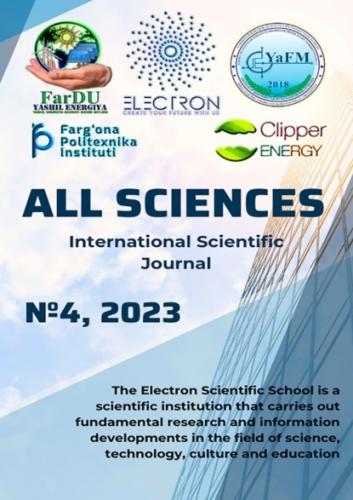7. Levanok A. P., Osipov V. V. Mechanisms of the photorefractive effect. // Izv. An. Russia, 1977. Vol.41. No. 4. C.752—769.
8. Sturman B. I., Fridkin V. M. Photovoltaic effects in media without an inversion center. M.: Nauka. 1992. 208 P.
9. Friedkin V. M. //Volumetric photovoltaic effect in crystals without a center of symmetry. Crystallography. 2001. Vol. 46 No.4. pp.722—726.
10. Fridkin V. M., Magomadov R. M. Anomalous photovoltaic effect in LiNbO3: Fe in polarized light. //w. Pisma ZhETF. 1979.t30.P.723-726.
11. Encyclopedia. The entry was published on 27.09.2002 at 00:00 in the following headings: …news archive 2002—2007.
TECHNICAL SCIENCES
TECHNOLOGY OF OBTAINING AND STUDYING A FILM THERMOGENERATOR
UDC 621.362
Yuldashaliev Dilshod Kuldoshalievich
lecturer of the Department of "Professional Education" of Fergana State University
Usmanov Yakub
Associate Professor of the Department of "Professional Education" of Fergana State University
Akhmedov Tursunakhmedovich
Associate Professor of the Department of "Professional Education" of Fergana State University
Karimov Bahodir Hashimovich
Associate Professor of the Department of "Professional Education" of Fergana State University
Ferghana State University, Ferghana, Uzbekistan
Annotation. The Seebeck effect (thermo-EMF) is used to convert thermal energy into electrical energy. The transfer of heat by electric current (Peltier effect) underlies the action of solid-state cooling and thermostatic devices. Thermoelectric energy converters have unique combinations of design and operational characteristics, such as the absence of moving parts, working fluids and gases, high reliability, the ability to operate for several years without maintenance or with minimal periodic maintenance, etc.
Keywords: thermogenerator, thermoelements, Peltier effect, thermoelectric materials, film thermogenerator, thermo-EMF, application of film thermogenerator.
Аннотация. Эффект Зеебека (термо-ЭДС) используется для преобразования тепловой энергии в электрическую. Перенос тепла электрическим током (эффект Пельтье) лежит в основе действия твердотельных охлаждающих и термостатирующих устройств. Термоэлектрические преобразователи энергии обладают уникальными сочетаниями конструктивных и эксплуатационных характеристик, таких, как отсутствие движущихся деталей, рабочих жидкостей и газов, высокая надёжность, возможность эксплуатации в течение нескольких лет без обслуживания или при минимальном периодическом обслуживании и др.
Ключевые слова: термогенератор, термоэлементы, эффект Пельтье, термоэлектрические материалы, плёночный термогенератор, термо-ЭДС, применение плёночного термогенератора.
These advantages determine the variety of use of thermogenerators as power sources, mainly for autonomous systems – in space, in hard-to-reach areas of land and sea, etc. Thermoelectric refrigerators and thermostats are used in instrumentation, IR technology, medicine, biology, household appliances. There is also a wide range of applications of thermoelectric devices in measuring technology, thermometry, pyrometry, electrical measurements, etc.
Many of the tasks that practice sets for developers of thermoelectric devices can be successfully solved with the use of film thermogenerators (PTG). The obvious advantage of PTG is the ability to fundamentally increase the number of elements while maintaining the volume of the converter, and, if necessary, create microminiature devices. Small-sized power supplies, low-current micro-coolers and thermostats, highly sensitive and sufficiently low-inertia temperature and heat flow sensors, etc. can be manufactured on the basis of PTG. Vacuum technology significantly simplifies the assembly process and shortening the manufacturing time of thermogenerators, allows combining elements and circuits of radio and optoelectronics with thermoelectric devices in a single design and manufacturing in a single technological cycle.
The results of physical and technological research, design developments have made significant progress in the field of film thermoelectric converters.
To date, the fundamental possibility of creating PTGS with energy characteristics close to volumetric ones has been proven, the technology of their mass production has been developed, a number of devices based on them have been created. The new thermoelectric temperature and radiant flux sensors have an order of magnitude higher sensitivity.
The successes achieved in the creation of highly efficient PTGS will undoubtedly lead to their wide technical application, which in turn will require further development of physical and technological research, expansion of the front of design developments. In this regard, it is urgent to develop a technology for obtaining PTG and new design developments, as well as to investigate electro and thermophysical properties.
The working substance in modern thermoelectric converters are semiconductors, the selection and optimization of the properties of which are based on the theory developed by academician A.F.Ioffe. The quality of the material is characterized by thermoelectric efficiency z = α2 σ/χ, where α is the coefficient of thermo-EMF, σ and χ are their specific electrical and thermal conductivity. The higher the value of the dimensionless parameter zT (T is the operating temperature), the greater the efficiency of the thermogenerator.
The technology for producing a film thermogenerator is based on the thermal evaporation of semiconductor materials in vacuum or in an atmosphere of various gases.
The technological mode of obtaining a film thermogenerator depends on a large number of parameters, such as the temperature of the evaporator and the substrate, the thickness of the film, the composition and pressure of residual gases in the vacuum chamber, the conditions of thermal and chemical treatment of films after spraying. At the same time, each semiconductor material has its own optimal mode, and often small deviations from it even by one of the parameters lead to the disappearance of the thermal effect in the manufactured films. For this reason, the development of a technology for obtaining a film thermogenerator from a particular material requires a lot of experimental work, a large number of test spraying with successive variation of several technological parameters, their combinations and finding parameters specific to obtaining a tarmoeffect on films from this semiconductor material.
We have developed a technology for producing a thermogenerator from Bi-Sb materials.
Film thermogenerators were obtained by spraying a semiconductor material from a crucible in a vacuum of ~10-5 mmHg on various substrates (aluminum, honey, brass, iron, mica, sapphire and ceramics) heated from 20-250 ° C and located at an angle of 90 ° in the direction of the molecular beam.
An optimal mode has been developed and a substrate
